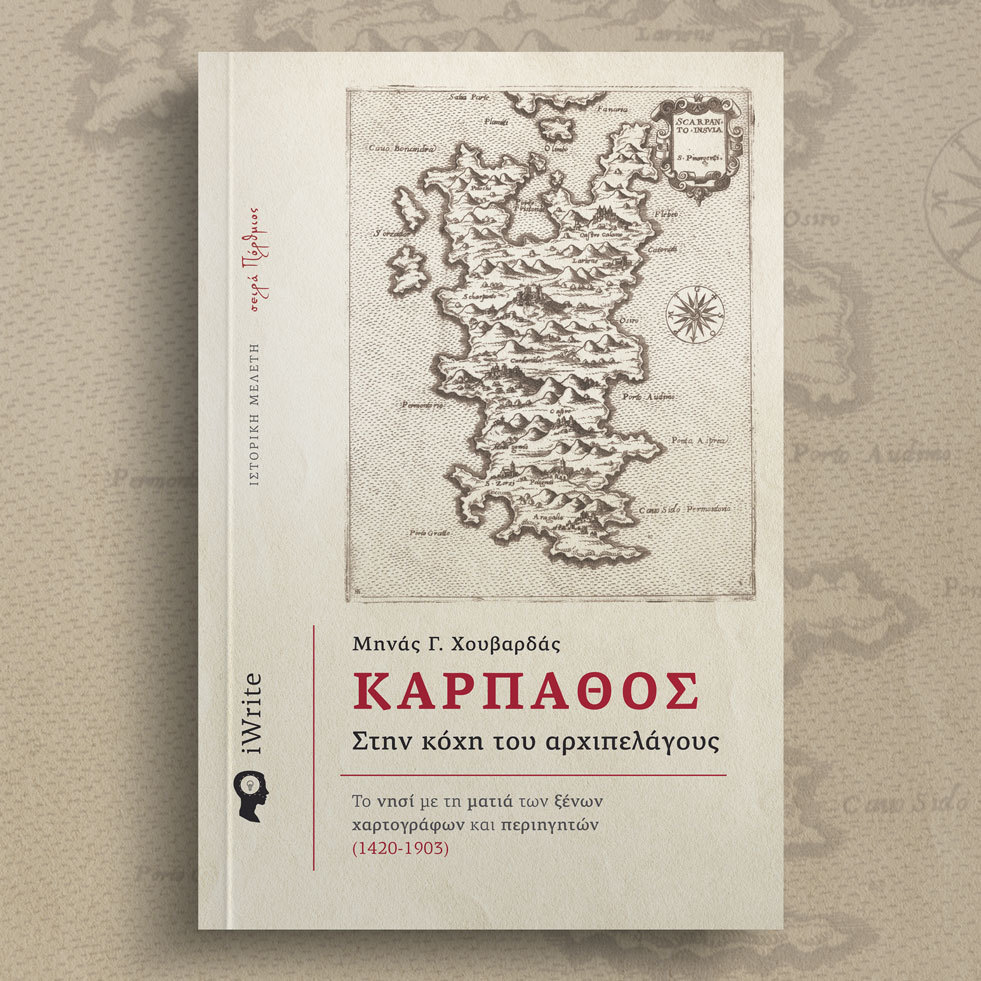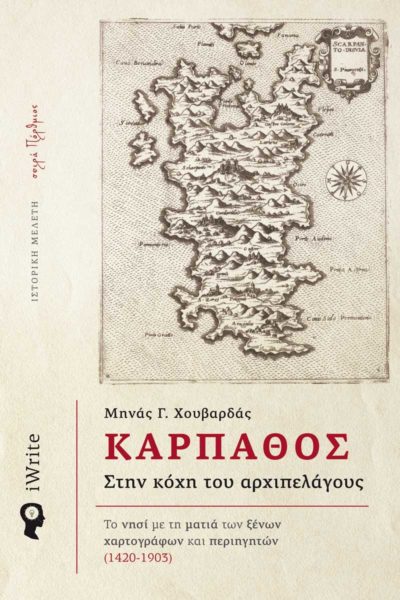Γράφει ο συγγραφέας Μηνάς Χουβαρδάς (βιβλίο «Κάρπαθος – Στη κόχη του αρχιπελάγους»)
Η περίπτωση του James Theodore Bent
Από εκείνους τους ξένους περιηγητές που επισκέφθηκαν την Κάρπαθο κατά τον 19ο αιώνα, ο James Theodore Bent είναι ο μόνος που δίνει λεπτομερείς πληροφορίες για την εθνολογική σύσταση της Καρπάθου, τα αρχαιολογικά ευρήματα, για τα ήθη και τα έθιμα του νησιού όπως τα βίωσε την εποχή που βρέθηκε εκεί, για την καρπαθιακή διάλεκτο, για την καθημερινή ζωή και τις ασχολίες των κατοίκων. Παραδόξως το σημαντικότατο έργο του, που αφορά κυρίως τη λαογραφία του νησιού κατά τα τέλη του 19ου αι., πέρασε απαρατήρητο από τους σύγχρονους μελετητές. Χάρη στη δίμηνη παραμονή του στην Κάρπαθο, καταγράφει πληθώρα πληροφοριών σχετικά με τις προλήψεις και τις δεισιδαιμονικές πρακτικές των Καρπαθίων.
Σύμφωνα με τον περιηγητή, η επίδραση των δεισιδαιμονιών στο νησί ήταν πολύ μεγάλη:
«Οι Καρπάθιοι ζουν στα βάθη της δεισιδαιμονίας, με τις προφητείες και τα ξόρκια τους. Ένας γιατρός βρίσκεται στην πρωτεύουσα· αλλά αυτός μου είπε ότι οι πρακτικές του περιορίζονται σχεδόν αποκλειστικά στους Τούρκους και σε μερικούς πεφωτισμένους Έλληνες.
Στα ορεινά χωριά ποτέ δεν διανοούνται να καλέσουν κανέναν στους αρρώστους, αλλά μόνο τις γριές μάγισσες, οι οποίες μουρμουρίζουν τα ξόρκια και κυματίζουν ένα μυστηριώδες δρεπάνι με περίεργες χειρονομίες πάνω από τους ασθενείς τους· ή μερικές φορές καλείται ένας ιερέας, διότι ισχυρίζονται ότι μπορούν να δέσουν τις ασθένειες, ειδικά τους πυρετούς, στα δέντρα, γράφοντας σε ένα κομμάτι χαρτιού τις απόκρυφες λέξεις “η αγιότητα του Θεού, θείο μυστήριο”.
Αυτά δένονται με ένα κόκκινο νήμα γύρω από τον λαιμό του πάσχοντα· το επόμενο πρωί τα αφαιρούν και πηγαίνουν έξω στην πλαγιά του λόφου, όπου τα δένουν πάνω σε ένα δέντρο και φαντάζονται ότι έτσι μεταφέρουν τον πυρετό από τον ασθενή στο κλαδί…»
Ανηφορίζοντας το μονοπάτι από το λιμάνι των Πηγαδιών προς το Απέρι, την τότε πρωτεύουσα του νησιού, καταγράφει την «ύπαρξη» νεράιδων στη θέση του χειμάρρου «Χα» (Χάος):
«αποβιβαστήκαμε στην πιο πυκνοκατοικημένη γωνιά του νησιού, όπου ένας αριθμός χωριών βρίσκεται επάνω από ένα γόνιμο φαράγγι μακριά μέσα στα βουνά, κάτω εκεί όπου ένας χείμαρρος κυλά ορμητικά, ο οποίος ονομάζεται “Χάος”, ρέοντας αφρισμένα μέσα από χάσματα πλάτους μόλις δύο γιαρδών. Θεωρείται ο πιο αλλόκοτος χείμαρρος, τον οποίο κανένας άνθρωπος δεν τολμά να πλησιάσει τη νύχτα εξαιτίας του φόβου των νεράιδων και των άλλων πνευμάτων του νερού…»
Κατά την παραμονή του στο χωριό της Βολάδας βρέθηκε σε πολύ δυσάρεστη θέση, όταν ηλικιωμένες γυναίκες του χωριού κατάλαβαν πως εκείνος τις σκιτσογραφούσε, καθώς συζήταγε μαζί τους:
«…κάθε απόγευμα μια ομάδα ηλικιωμένων γυναικών θα έρχονταν για να μας κρατήσουν συντροφιά με τα πρόσωπά τους τυλιγμένα σε μαντήλες. Μας ανέφεραν τοπικά έθιμα και δοξασίες από μια παράδοξη φύση. Ένα βράδυ προσπάθησα να σκιτσογραφήσω αυτές τις ηλικιωμένες γκιόσες και αποκαλύφθηκε τι έκανα. Νόμιζα πως θα μου βγάλουν τα μάτια και το σκίτσο μου καταστράφηκε εξαιτίας της “αναίδειάς” μου, τόσο εξοργισμένες ήταν· διότι πίστευαν πως εάν τα πορτραίτα τους απεικονίζονταν, εκείνες θα χάνονταν και θα πέθαιναν…».
Με αφορμή τον θάνατο μιας νεαρής γυναίκας περιγράφει τις ταφικές πρακτικές και τις δοξασίες που τις αφορούν:
«δεν τοποθετούν ποτέ το σώμα μέσα σε φέρετρο στην Κάρπαθο, επειδή υπάρχει μια δημοφιλής δοξασία πως αν η ψυχή κλειστεί σε ξύλο δεν μπορεί να ξεφύγει. Ένα χρόνο μετά τον θάνατο τα οστά ξεθάβονται, τοποθετούνται σε μια κεντητή σακούλα και ρίχνονται μέσα σε ένα οστεοφυλάκιο κάτω από το παρεκκλήσι. Πιστεύουν πως αν δεν αποσυντεθεί εντελώς η σάρκα από τα οστά, η ψυχή δεν αναπαύεται εν ειρήνη· κατά συνέπεια η διαδικασία του ανοίγματος ενός τάφου είναι πολύ αγχωτική για τους ζωντανούς, οι οποίοι μπορούν να διαπιστώσουν με αυτόν τον τρόπο τον προορισμό της ψυχής των νεκρών φίλων τους.
Όταν υπάρχει οποιαδήποτε καχυποψία για το αν ο πεθαμένος δεν αναπαύεται στον Άδη, το όνομά του μπαίνει χωρίς καθυστέρηση στο “χαρτί των ψυχών”, στη λίστα των ψυχών στα μνημόσυνα του ιερέα, για τις οποίες θα πρέπει να προσευχηθεί κατά τη διάρκεια του ιερού μυστηρίου. Πολλές δεισιδαιμονικές πρακτικές υπάρχουν που συνδέονται με την ανησυχία των ψυχών.
Κάποιες φορές οι στάχτες μεταφέρονται σε μια βραχονησίδα, επειδή τα φαντάσματα δεν μπορούν να διασχίσουν το νερό· άλλες φορές καίγονται και διασκορπίζονται στους ανέμους· και ένας ετοιμοθάνατος άνθρωπος δεν θα πρέπει να καλύπτεται ποτέ με οποιοδήποτε υλικό από μαλλί αίγας, επειδή θα φυλακίσει το πνεύμα, ούτε θα πρέπει να δοθεί οτιδήποτε απέναντι από μια σορό για τον ίδιο λόγο· και ποτέ δεν κουμπώνουν τα ρούχα που βάζουν μετά από θάνατο: στο τέλος αφαιρούν όλα τα δαχτυλίδια, επειδή το πνεύμα, λένε, μπορεί να κρατηθεί στο μικρό δάχτυλο και να μην μπορεί να αναπαυθεί…».
Ο Bent παρατηρώντας τα οστά των νεκρών στον χώρο του νεκροταφείου, κρίνει αρνητικά τη συνήθεια που επικρατούσε στην Κάρπαθο να διατηρούν οστεοφυλάκια:
«ακόμη και με όλη αυτή την υπερβολική θλίψη, είναι εκπληκτικό να βλέπουμε πόσο εφήμερος είναι ο σεβασμός που αποδίδεται στα εντελώς απογυμνωμένα οστά. Πολλά από τα οικογενειακά οστεοφυλάκια έχουν καταντήσει ερείπια εξαιτίας της παραμέλησης και οι κεντητές σακούλες, τις οποίες ήμουν σχεδόν σε πειρασμό να κλέψω, ήταν διάσπαρτες ολόγυρα, με τα οστά να πετάγονται έξω. Μια συγκεκριμένη περίπτωση μας έκανε εντύπωση: ήταν το οστεοφυλάκιο που ανήκε στον αρχιερέα του χωριού, το οποίο είχε σχεδόν παρασυρθεί από τη χειμωνιάτικη βροχή.
Παντού τριγύρω βρίσκονταν τα κρανία και τα οστά, ανακατωμένα φρικτά, των νεκρών του συγγενών, μεταξύ των οποίων θα περιφερόταν ένα βράδυ μια γριά μάγισσα σαν γκιόσα, για να συλλέξει τέτοια κόκαλα, καθώς εκείνα θεωρούνταν χρήσιμα για ξόρκια. Για παράδειγμα, μια νεκροκεφαλή που τοποθετείται πάνω σε μια θέση προς την κατεύθυνση που επιθυμούν ο αέρας να φυσήξει, θεωρείται αποτελεσματικό για να παραχθεί το επιθυμητό ρεύμα αέρα και δεν τους κακοφαίνεται, σαν μια φρικτή ιδέα, ότι για αυτόν εδώ τον σκοπό χρησιμοποιείται το κρανίο κάποιου εκλιπόντος αγαπημένου τους προσώπου…».
Τέλος, πολλές ήταν, σύμφωνα με τον Άγγλο περιηγητή, και οι προλήψεις που αφορούσαν τα βρέφη στην Κάρπαθο.
Υπήρχε διαδεδομένη η πίστη πως τα βρέφη, ως ασθενείς οργανισμοί, υπόκεινται περισσότερο από κάθε άλλο άτομο σε ασθένειες, στη βασκανία και στον ίδιο τον θάνατο. Προς αποφυγή τους, υπήρχαν διάφορες προλήψεις, όπως π.χ. να μην εκτίθενται τα σπάργανα ή τα λευκά είδη του βρέφους τη νύχτα στην ύπαιθρο για να μην αποκτήσει αυτό εξανθήματα ως επήρεια των άστρων:
«Ο δάσκαλος μας είπε πολλά σχετικά με τις δεισιδαιμονίες που σχετίζονται με τις γεννήσεις εκείνο το απόγευμα. Κατά το ηλιοβασίλεμα, για πολλές μέρες, οι θύρες των σπιτιών διατηρούνται ερμητικά κλειστές σε οποιονδήποτε θα μπορούσε να έλθει. Ακόμα κι αν ήταν ο πατέρας που επέστρεφε από μακρινό ταξίδι, θα έπρεπε να αναζητήσει αλλού ανάπαυση, διότι από το ηλιοβασίλεμα έως τα ξημερώματα οι αέρινοι δαίμονες περιπλανιούνται και θα μπορούσαν να εισέλθουν και να βλάψουν το παιδί.
Τα ρούχα του παιδιού δεν θα πρέπει να εκτίθενται στ’ άστρα, κι αν κατά λάθος έχουν εκτεθεί, θα πρέπει να λιβανιστούν με το θυμιατήρι· αν δεν γίνει αυτό το παιδί θα βγάλει εξανθήματα… Οι νεράιδες δεν επιθυμούν τίποτε καλύτερο από το να χτυπήσουν τα παιδιά με μια μυστηριώδη φθορά· άπληστη λάμια θα ρουφήξει το αίμα τους.
Το κακό μάτι τα επηρεάζει περισσότερο από τους ενήλικες και για να αντιμετωπίσουν αυτούς τους κινδύνους οι μητέρες θα υποβάλουν τα παιδιά τους σε αναρίθμητα βάσανα. Αν το παιδί είναι αδύναμο και νεραϊδοχτυπημένο, θα πρέπει να αφεθεί γυμνό στον κρύο μαρμάρινο βωμό της εκκλησίας για μερικές ώρες· αν ένα παιδί για κάποιον λόγο είναι διεστραμμένο, έχει χτυπηθεί από το γέλιο της νεράιδας λένε, και η μόνη σωτηρία είναι ο εξορκισμός του ιερέα…»
Περισσότερες πληροφορίες για τα έθιμα και τη ζωή στην Κάρπαθο από τις εκδόσεις iWrite


